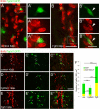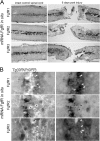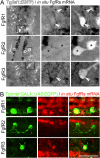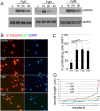Different Fgfs have distinct roles in regulating neurogenesis after spinal cord injury in zebrafish
- PMID: 30447699
- PMCID: PMC6240426
- DOI: 10.1186/s13064-018-0122-9
Different Fgfs have distinct roles in regulating neurogenesis after spinal cord injury in zebrafish
Abstract
Background: Despite conserved developmental processes and organization of the vertebrate central nervous system, only some vertebrates including zebrafish can efficiently regenerate neural damage including after spinal cord injury. The mammalian spinal cord shows very limited regeneration and neurogenesis, resulting in permanent life-long functional impairment. Therefore, there is an urgent need to identify the cellular and molecular mechanisms that can drive efficient vertebrate neurogenesis following injury. A key pathway implicated in zebrafish neurogenesis is fibroblast growth factor signaling.
Methods: In the present study we investigated the roles of distinct fibroblast growth factor members and their receptors in facilitating different aspects of neural development and regeneration at different timepoints following spinal cord injury. After spinal cord injury in adults and during larval development, loss and/or gain of Fgf signaling was combined with immunohistochemistry, in situ hybridization and transgenes marking motor neuron populations in in vivo zebrafish and in vitro mammalian PC12 cell culture models.
Results: Fgf3 drives neurogenesis of Islet1 expressing motor neuron subtypes and mediate axonogenesis in cMet expressing motor neuron subtypes. We also demonstrate that the role of Fgf members are not necessarily simple recapitulating development. During development Fgf2, Fgf3 and Fgf8 mediate neurogenesis of Islet1 expressing neurons and neuronal sprouting of both, Islet1 and cMet expressing motor neurons. Strikingly in mammalian PC12 cells, all three Fgfs increased cell proliferation, however, only Fgf2 and to some extent Fgf8, but not Fgf3 facilitated neurite outgrowth.
Conclusions: This study demonstrates differential Fgf member roles during neural development and adult regeneration, including in driving neural proliferation and neurite outgrowth of distinct spinal cord neuron populations, suggesting that factors including Fgf type, age of the organism, timing of expression, requirements for different neuronal populations could be tailored to best drive all of the required regenerative processes.
Keywords: C-met; Fgf2; Fgf3; Fgf8; Islet 1; Motor neuron; Neural regeneration.
Conflict of interest statement
Ethics approval and consent to participate
All experiments were conducted in accordance with Monash University guidelines and approved by the local ethics committee.
Consent for publication
Not applicable.
Competing interests
The authors declare that they have no competing interests.
Publisher’s Note
Springer Nature remains neutral with regard to jurisdictional claims in published maps and institutional affiliations.
Figures







Similar articles
-
Wnt/ß-catenin signaling is required for radial glial neurogenesis following spinal cord injury.Dev Biol. 2015 Jul 1;403(1):15-21. doi: 10.1016/j.ydbio.2015.03.025. Epub 2015 Apr 14. Dev Biol. 2015. PMID: 25888075 Free PMC article.
-
Characterization of Proliferating Neural Progenitors after Spinal Cord Injury in Adult Zebrafish.PLoS One. 2015 Dec 2;10(12):e0143595. doi: 10.1371/journal.pone.0143595. eCollection 2015. PLoS One. 2015. PMID: 26630262 Free PMC article.
-
Radial glial progenitors repair the zebrafish spinal cord following transection.Exp Neurol. 2014 Jun;256:81-92. doi: 10.1016/j.expneurol.2014.03.017. Epub 2014 Apr 8. Exp Neurol. 2014. PMID: 24721238 Free PMC article.
-
Macrophage-Neuroglia Interactions in Promoting Neuronal Regeneration in Zebrafish.Int J Mol Sci. 2023 Mar 30;24(7):6483. doi: 10.3390/ijms24076483. Int J Mol Sci. 2023. PMID: 37047456 Free PMC article. Review.
-
Zebrafish as a translational regeneration model to study the activation of neural stem cells and role of their environment.Rev Neurosci. 2018 Dec 19;30(1):45-66. doi: 10.1515/revneuro-2018-0020. Rev Neurosci. 2018. PMID: 30067512 Review.
Cited by
-
scRNA-sequencing reveals subtype-specific transcriptomic perturbations in DRG neurons of PirtEGFPf mice in neuropathic pain condition.Elife. 2022 Oct 20;11:e76063. doi: 10.7554/eLife.76063. Elife. 2022. PMID: 36264609 Free PMC article.
-
Age and Sex-Related Changes to Gene Expression in the Mouse Spinal Cord.J Mol Neurosci. 2019 Nov;69(3):419-432. doi: 10.1007/s12031-019-01371-3. Epub 2019 Jul 2. J Mol Neurosci. 2019. PMID: 31267314
-
Building bridges, not walls: spinal cord regeneration in zebrafish.Dis Model Mech. 2020 May 27;13(5):dmm044131. doi: 10.1242/dmm.044131. Dis Model Mech. 2020. PMID: 32461216 Free PMC article. Review.
-
Modeling traumatic brain and neural injuries: insights from zebrafish.Front Mol Neurosci. 2025 Mar 27;18:1552885. doi: 10.3389/fnmol.2025.1552885. eCollection 2025. Front Mol Neurosci. 2025. PMID: 40213159 Free PMC article. Review.
-
In toto imaging of glial JNK signaling during larval zebrafish spinal cord regeneration.Development. 2023 Dec 15;150(24):dev202076. doi: 10.1242/dev.202076. Epub 2023 Dec 11. Development. 2023. PMID: 37997694 Free PMC article.
References
-
- Dono R. Fibroblast growth factors as regulators of central nervous system development and function. Am J Phys Regul Integr Comp Phys. 2003;284(4):R867–R881. - PubMed
Publication types
MeSH terms
Substances
LinkOut - more resources
Full Text Sources
Medical
Molecular Biology Databases
Research Materials
Miscellaneous

